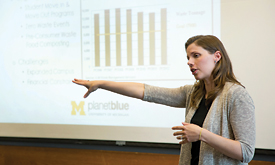
The latest sustainability-related efforts on campus — from creating “compost tea” liquid fertilizer to efficiency upgrades for buildings and vehicles — were on the discussion menu at a Campus Sustainability Town Hall forum Oct. 4.
Attendees at the Michigan Union heard from panelists who reported on progress toward meeting sustainability goals and fielded questions from the audience.
“It’s another way to reach out to the campus community to inform them of sustainability efforts across campus, and a chance to get direct feedback from students, faculty, and staff on our sustainability efforts. It also enables us to hear about areas the campus community views as a source for future opportunities,” said Andrew Berki, manager of the Office of Campus Sustainability.
The town hall came nearly one year after President Mary Sue Coleman announced sustainability goals:
• Cut U-M greenhouse gas emissions by 25 percent from 2006 levels by 2025.
• Make the university transportation system more efficient by decreasing vehicle carbon output by 30 percent for every person in the car, truck or bus.
• Shrink the amount of waste sent to landfills by 40 percent.
• Protect the Huron River through stormwater-control strategies and by applying 40 percent less chemicals to campus landscapes.

Tracy Artley, sustainability program coordinator with Plant Building and Grounds Services, discusses a Back-to-Basics recycling campaign during the Campus Sustainability Town Hall forum. Photo by Scott Soderberg, Michigan Photography.
• Promote sustainable foods by committing to receive at least 20 percent of U-M food from local and sustainable sources.
Berki said efforts to meet energy conservation goals include lighting efficiency upgrades in the Modern Languages Building (MLB) and School of Public Health, and energy-efficient window projects in the School of Dentistry, Harlan Hatcher Graduate Library and the MLB. Fume hood energy-efficiency projects have been completed in the Chemistry Building, School of Public Health II and the Dow Building.
“Energy conservation measures in our buildings range from large-scale energy-efficient window replacement projects to new chiller systems to increase the efficiency in how we heat and cool buildings. We’re committed to the goals and are continuing to invest in a variety of cost-effective initiatives toward accomplishing them,” Berki said. He said a steam absorption chiller program initiated at the North Campus Chiller Plant alone has cut more than 2 million kilowatt hours of electricity purchases per year.
Anya Dale, sustainability representative from the Office of Campus Sustainability, said grounds crews around campus have been seeking more efficient ways to apply chemicals, pesticides and fertilizers, and seeking to identify fewer areas for such applications.
“We’re continuing to develop guidelines to reduce those numbers, and we’re better defining what are bad chemicals and what’s OK to apply,” she said.
One pilot program at Plant Building and Grounds Services mixes compost with water to produce a compost tea, or watery compost solution that can replace fertilizer applications. Five locations on campus, including the Diag, currently receive the compost tea treatments.
To meet the goal of having 20 percent of campus food sustainably sourced, guidelines are being developed to obtain food within 250 miles, organic or humanely raised, or third-party-certified as being sustainable.
“We are talking with vendors and evaluating our options. There’s been a lot of efforts on campus to bring in farmers’ markets and local produce carts, and the Sustainable Food Program is establishing a farm on campus,” Dale said.
Tracy Artley, sustainability program coordinator with Plant Building and Grounds Services, said a Back-to-Basics campaign seeks to promote recycling campuswide by updating signage to uniformly brand the program and reinforce what is recyclable.
“We are conducting a food waste composting pilot program in the Michigan League through Thanksgiving” to document successes, challenges and true costs associated with collecting this type of waste for composting, she said.
Steve Dolan, executive director of Parking & Transportation Services, said that to meet carbon emission-reduction goals, his unit has initiated popular express bus services to Canton and Chelsea, pursued ride sharing, and has witnessed an increase in vanpool use.
“We have about 625 employees using vanpools at the university right now. These are going very well,” he said. Dolan says his department plans to put more bike racks at campus buildings, and is establishing a bike-rental program with local partners next year.
Raymond De Young, associate professor of environmental psychology and planning, School of Natural Resources and Environment, and adjunct associate professor of Program in the Environment, LSA, addressed the subject of how to promote the notion of behavior entrepreneurship among students, staff, faculty and alumni. With a change in culture, the needed sustainability efforts would be accepted long term by the greater university public.
“We’re going to have to be patient,” he said, adding it’s been proven in various settings that people can be trusted to embrace sustainability practices but that durable change emerges only slowly.During an audience-question period, Nancy Kelly, administrative assistant senior with the U-M Health System, who served on the Voices of the Staff Environmental Stewardship Team, urged the panel to maintain Planet Blue Ambassadors. They promote and teach sustainability practices to the U-M community.
“I like that they were bridging the concerns of staff, students, the Medical Campus and Central Campus. This is a forum to keep that conversation going,” she said.

